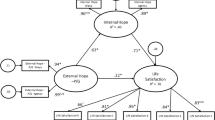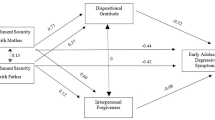Abstract
Decades of research confirm familial links in mental illness, but little is known about the relationships between parents’ and children’s levels of positive emotions. The current study used a past, present, and future framework of positive emotions to explore parent and child levels of gratitude, life satisfaction, and hope. Correlations between self-reported levels of gratitude, life satisfaction, and hope were analyzed in a sample of 148 fourth and fifth grade students and their biological parents (137 mothers, 109 fathers). Findings include statistically significant relationships between (1) mother and child gratitude (but not father and child gratitude) and (2) child life satisfaction and both mothers’ and fathers’ life satisfaction. No significant relationships emerged between parent hope and child hope, although higher parent life satisfaction was associated with higher child hope. Research is needed to investigate the causes of the links identified in the current study.
Similar content being viewed by others
References
Adelman, H. S., Taylor, L., & Nelson, P. (1989). Minors’ dissatisfaction with their life circumstances. Child Psychiatry and Human Development, 20, 135–147.
Adler, M. G., & Fagley, N. S. (2005). Appreciation: Individual differences in finding value and meaning as a unique predictor of subjective well-being. Journal of Personality, 73, 79–114.
Andrews, F. M., & Withey, S. B. (1976). Social indicators of well-being. New York: Plenum Press.
Barkley, R. A., & Cunningham, C. E. (1979). The effects of methylphenidate on the mother–child interactions of hyperactive children. Archives of General Psychiatry, 36, 201–208.
Ben-Zur, H. (2003). Happy adolescents: the link between subjective well-being, internal resources, and parental factors. Journal of Youth and Adolescence, 32, 67–79.
Bianchi, S. M., Robinson, J. P., & Milkie, M. A. (2006). Changing rhythms of American family life. New York: Russell Sage Foundation.
Casas, F., Coenders, G., Cummins, R., González, M., Figuer, C., & Malo, S. (2008). Does subjective well-being show a relationship between parents and their children? Journal of Happiness Studies, 9, 197–205.
Chang, E. C. (1998). Hope, problem-solving ability, and coping in a college student population: Some implications for theory and practice. Journal of Clinical Psychology, 54, 953–962.
Chen, C., Shen, H., & Li, X. (2009). Reliability and validity of adult dispositional Hope Scale. Chinese Journal of Clinical Psychology, 17, 24–26.
Ciarrocchi, J. W., Dy-Liacco, G. S., & Deneke, E. (2008). Gods or rituals? Relational faith, spiritual discontent, and religious practices as predictors of hope and optimism. Journal of Positive Psychology, 3, 120–136.
Cohen, J. (1988). Statistical power analysis for the behavioral sciences (2nd ed.). Hillsdale, NJ: Erlbaum.
Cummins, R. A., Eckersley, R., Pallant, J., van Vugt, J., & Misajon, R. (2003). Developing a national index of subjective well being: The Australian unity well-being index. Social Indicators Research, 64, 159–190.
Diener, E., Emmons, R., Larsen, R., & Griffin, S. (1985). The satisfaction with life scale. Journal of Personality Assessment, 49, 71–75.
Eid, M., & Larsen, R. J. (2008). The science of subjective well-being. New York: Guilford Press.
Eley, T. C. (2001). Contributions of behavioral genetics research: Quantifying genetic, shared environmental and nonshared environmental influences. In M. W. Vasey & M. R. Dadds (Eds.), The developmental psychopathology of anxiety (pp. 45–59). London: Oxford University Press.
Emmons, R., & Kneezel, T. (2005). Giving thanks: Spiritual and religious correlates of gratitude. Journal of Psychology and Christianity, 24, 140–148.
Faraone, S., Spencer, T., Aleardi, M., Pagano, C., & Biederman, J. (2004). Meta-analysis of the efficacy of methylphenidate for treating adult attention-deficit/hyperactivity disorder. Journal of Clinical Psychopharmacology, 24, 24–29.
Fredrickson, B. L., & Kurtz, L. E. (2011). Cultivating positive emotions to enhance human flourishing. In S. I. Donaldson, M. Csikszentmihalyi, J. Nakamura, S. I. Donaldson, M. Csikszentmihalyi, & J. Nakamura (Eds.), Applied positive psychology: Improving everyday life, health, schools, work, and society (pp. 35–47). New York: Routledge.
Froh, J. J., Emmons, R. A., Card, N. A., Bono, G., & Wilson, J. (2011a). Gratitude and the reduced costs of materialism in adolescents. Journal of Happiness Studies, 12, 289–302.
Froh, J. J., Fan, J., Emmons, R. A., Bono, G., Huebner, E., & Watkins, P. (2011b). Measuring gratitude in youth: Assessing the psychometric properties of adult gratitude scales in children and adolescents. Psychological Assessment, 23, 311–324.
Froh, J. J., Yurkewicz, C., & Kashdan, T. B. (2009). Gratitude and subjective well-being in early adolescence: Examining gender differences. Journal of Adolescence, 32, 633–650.
Gibb, J. (1990). The Hope Scale revisited—further validation of a measure of individual differences in the hope motive. Unpublished Master’s thesis, University of Illinois at Urbana Champaign.
Gilman, R. C., & Huebner, E. S. (1997). Children’s reports of their life satisfaction: Convergence across raters, time, and response formats. School Psychology International, 18, 133–147.
Gilman, R., & Huebner, E. S. (2006). Characteristics of adolescents who report very high life satisfaction. Journal of Youth and Adolescence, 35, 311–319.
Greif, E. B., & Gleason, J. B. (1980). Hi, thanks, and goodbye: More routine information. Language in Society, 9, 59–66.
Haque, F. N., Gottesman, I. I., & Wong, A. H. C. (2009). Not really identical: Epigenetic differences in monozygotic twins and implications for twin studies in psychiatry. American Journal of Medical Genetics, 151C, 136–141.
Huebner, E. S. (1991). Initial development of the Students’ Life Satisfaction Scale. School Psychology International, 12, 231–240.
Huebner, E. S., & Dew, T. (1993). An evaluation of racial bias in a life satisfaction scale. Psychology in the Schools, 30, 305–309.
Kashdan, T., Mishra, A., Breen, W., & Froh, J. (2009). Gender differences in gratitude: Examining appraisals, narratives, the willingness to express emotions, and changes in psychological needs. Journal of Personality, 77, 691–730.
Kazdin, A. E., Rodgers, A., & Colbus, D. (1986). The Hopelessness Scale for Children: Psychometric characteristics and concurrent validity. Journal of Consulting and Clinical Psychology, 54, 241–245.
Kline, R. B. (2010). Principles and practice of structural equation modeling. New York: Guilford.
Kovacs, M. (1985). The Children’s Depression Inventory (CDI). Psychopharmacology Bulletin, 21, 995–998.
Lifford, K. J., Harold, G. T., & Thapar, A. (2008). Parent-child relationships and ADHD symptoms: A longitudinal analysis. Journal of Abnormal Child Psychology, 36, 285–296.
Lucas, R. E., Diener, E., & Larsen, R. J. (2009). Measuring positive emotions. In E. Diener & E. Diener (Eds.), Assessing well-being: The collected works of Ed Diener (pp. 139–155). New York, NY: Springer.
Lykken, D. (1999). Happiness: What studies on twins show us about nature, nurture, and the happiness set point. New York: Golden Books.
Lyubomirsky, S., Sheldon, K. M., & Schkade, D. (2005). Pursuing happiness: The architecture of sustainable change. Review of General Psychology, 9, 111–131.
Marques, S. C., Pais-Riberio, J. L., & Lopez, S. J. (2007). Relationship between children’s hope and guardian’s hope. Poster presented at the 10th European Congress of Psychology, Prague, Czech Republic.
McCullough, M., Emmons, R., & Tsang, J. (2002). The grateful disposition: A conceptual and empirical topography. Journal of Personality and Social Psychology, 82, 112–127.
Miller, D., & Nickerson, A. (2007). Changing the past, present, and future: potential applications of positive psychology in school-based psychotherapy with children and youth. Journal of Applied School Psychology, 24, 147–162.
Mowbray, C. T., Bybee, D., Oyserman, D., MacFarlane, P., & Bowersox, N. (2006). Psychosocial outcomes for adult children of parents with severe mental illnesses: Demographic and clinical history predictors. Health and Social Work, 31, 99–108.
Neugarten, B. L., Havighurst, R. J., & Tobin, S. S. (1961). The measurement of life satisfaction. Journal of Gerontology, 16, 134–143.
Papp, L. M., Goeke-Morey, M. C., & Cummings, E. (2004). Mothers’ and fathers’ psychological symptoms and marital functioning: Examination of direct and interactive links with child adjustment. Journal of Child and Family Studies, 13, 469–482.
Pavot, W., & Diener, E. (1993). Review of the Satisfaction with Life Scale. Psychological Assessment, 5, 164–172.
Peterson, C., & Seligman, M. E. P. (2004). Character strengths and virtues: A handbook and classification. Washington, DC: American Psychological Association.
Piers, E., & Harris, D. (1969). The Piers–Harris children’s self-concept scale. Nashville, TN: Counselor Recordings and Tests.
Scheier, M. F., & Carver, C. S. (1985). Optimism, coping, and health: Assessment and implications of generalized outcome expectancies. Health Psychology, 4, 219–247.
Seligman, M. E. P. (2002). Authentic happiness: Using the new positive psychology to realize your potential for lasting fulfillment. New York: Free Press.
Silberg, J. L., Maes, H., & Eaves, L. J. (2010). Genetic and environmental influences on the transmission of parental depression to children’s depression and conduct disturbance: An extended children of twins study. Journal of Child Psychology and Psychiatry, 51, 734–744.
Snyder, C. R. (2006). Measuring hope in children. Adolescent & Family Health, 4, 26–34.
Snyder, C. R., Harris, C., Anderson, J. R., Holleran, S. A., Irving, L. M., et al. (1991). The will and the ways: development and validation of an individual-differences measure of hope. Journal of Personality and Social Psychology, 60, 570–585.
Snyder, C. R., Hoza, B., Pelham, W. E., Rapoff, M., Ware, L., Danovsky, M., et al. (1997). The development and validation of the children’s hope scale. Journal of Pediatric Psychology, 22, 399–421.
Snyder, C. R., Rand, K. L., & Sigmon, D. R. (2005). Hope theory: A member of the positive psychology family. In C. R. Snyder & S. J. Lopez (Eds.), Handbook of positive psychology (pp. 257–267). New York: Oxford University Press.
Sommers, S., & Kosmitzki, C. (1988). Emotion and social context: An American–German comparison. British Journal of Social Psychology, 27, 35–49.
Steel, P., Schmidt, J., & Shultz, J. (2008). Refining the relationship between personality and subjective well-being. Psychological Bulletin, 134, 138–161.
Steger, M. F., Frazier, P., Oishi, S., & Kaler, M. (2006). The meaning in life questionnaire: Assessing the presence of and search for meaning in life. Journal of Counseling Psychology, 53, 80–93.
Steger, M. F., Hicks, B. M., Kashdan, T. B., Krueger, R. F., & Bouchard, T. (2007). Genetic and environmental influences on the positive traits of the values in action classification, and biometric covariance with normal personality. Journal of Research in Personality, 41, 524–539.
Suldo, S. M., & Huebner, E. (2004). Does life satisfaction moderate the effects of stressful life events on psychopathological behavior during adolescence? School Psychology Quarterly, 19, 93–105.
Terry, T., & Huebner, E. S. (1995). The relationship between self-concept and life satisfaction in children. Social Indicators Research, 35, 39–52.
Thomas, M., & Watkins, P. (2003). Measuring the grateful trait: Development of the revised GRAT. Poster session presented at the Annual Convention of the Western Psychological Association, Vancouver, BC.
Valle, M. F., Huebner, E., & Suldo, S. M. (2006). An analysis of hope as a psychological strength. Journal of School Psychology, 44, 393–406.
Weissman, M. M., Orvaschel, H., & Padian, N. (1980). Children’s symptoms and social functioning self report scales: Comparison of mothers’ and children’s reports. Journal of Nervous and Mental Disease, 168, 736–740.
Westburg, G. N., & Martin, D. (2003). The relationship between a child’s hope, a parent’s hope and student-directed, goal-oriented academic instruction. Journal of Humanistic Counseling, Education and Development, 42, 152–164.
Wood, A. M., Froh, J. J., & Geraghty, A. W. A. (2010). Gratitude and well-being: A review and theoretical integration. Clinical Psychology Review, 30, 890–905.
Wood, A. M., Maltby, J., Gillett, R., Linley, P., & Joseph, S. (2008). The role of gratitude in the development of social support, stress, and depression: Two longitudinal studies. Journal of Research in Personality, 42, 854–871.
Author information
Authors and Affiliations
Corresponding author
Rights and permissions
About this article
Cite this article
Hoy, B.D., Suldo, S.M. & Mendez, L.R. Links Between Parents’ and Children’s Levels of Gratitude, Life Satisfaction, and Hope. J Happiness Stud 14, 1343–1361 (2013). https://doi.org/10.1007/s10902-012-9386-7
Published:
Issue Date:
DOI: https://doi.org/10.1007/s10902-012-9386-7




